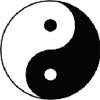Look again at the yin and yang symbol. See that white yang dot in the middle of the dark yin portion? There is no way to completely separate yin and yang. They are both present in every situation. Even in this six-step process of dealing with life, by allowing and watching events to unfold, there is a need for yang energy. Taking action is also present. This is not, however, the normal action of doing for the sake of doing; this is the action that arises naturally from the previous stages of allowing/accepting and watching.
In Daoism the term “wu-wei” literally means “without action.” It contains this paradox of action without action. This is often seen in the masters of the martial arts; with a minimum of action they achieve everything. This is a fundamental tenet of Daoist teachings: water is the most yielding of all elements and yet the most powerful. Gentle rains can wear a mountain to the ground.

In our practice we also act without acting. When fears or anxieties root us, make us unable to do anything, we act, we do what we must do. Despite the fear, despite the challenges facing us, despite our ego’s cries, we act. Because we have allowed the world to be the way it is, because we have accepted what is, and because we have watched and observed what is really going on, our action becomes skillful.
This sounds very reasonable but it is not very common. As we have seen earlier, normally we do one of three things when we are faced with challenges in our lives. Many people, when they are outside their comfort zone, will try to change the world. They will struggle to make the world become the way they want the world to be. Other people will recognize that they cannot change the world and instead will run away from it. They will figuratively hide under their beds and hope the challenges looking for them will pass them by. The world changers and the ostriches soon find out that these strategies don’t work very well. They may then join the third group of people, the people who simply give up. In a sullen, self-pitying funk, they submit to the pains of life and take every opportunity to let everyone around them know just how unfair life is.
Changing the world or running away from it are yang reactions that don’t work. Giving up is a yin reaction that also doesn’t work. Allowing, watching, and acting is a yin/yang way to meet life that does work.
For example, in the winter the weather becomes cold. If we were driven by our yang impulses we would try to change the weather or we would run away from the weather by moving to a warmer climate. Other people may stay put but they will complain bitterly about the fact that no one seems to be doing anything about this awful weather. The skillful way to deal with this unchangeable challenge is to allow the weather to be what it is, to watch how we feel because of this weather, and then to take appropriate action – to dress more warmly.
For people afflicted by phobias the same approach works: when facing a challenge that has taken you outside your comfort zone, allow the waves of fear to flow over you. Accept these feelings without judgment. Then watch; pay attention to what is really going on. Don’t imagine what is happening or try to color it in any way, just notice what is. Then take the action that your fear doesn’t want you to take – live your life – act skillfully, but do act.
When we practice yin yoga or yang yoga, we do the same things. We move outside our normal comfort zone; we allow the postures to flow around us, through us. We watch and notice the sensations arising, ebbing, and flowing. And, when appropriate, we take action, perhaps coming out of the pose if we have gone too deep or going deeper if the body mind has opened to that possibility.
Allow, watch, and act – that is basically the process – except we can’t just do it once.
(Next: Keep at it )
